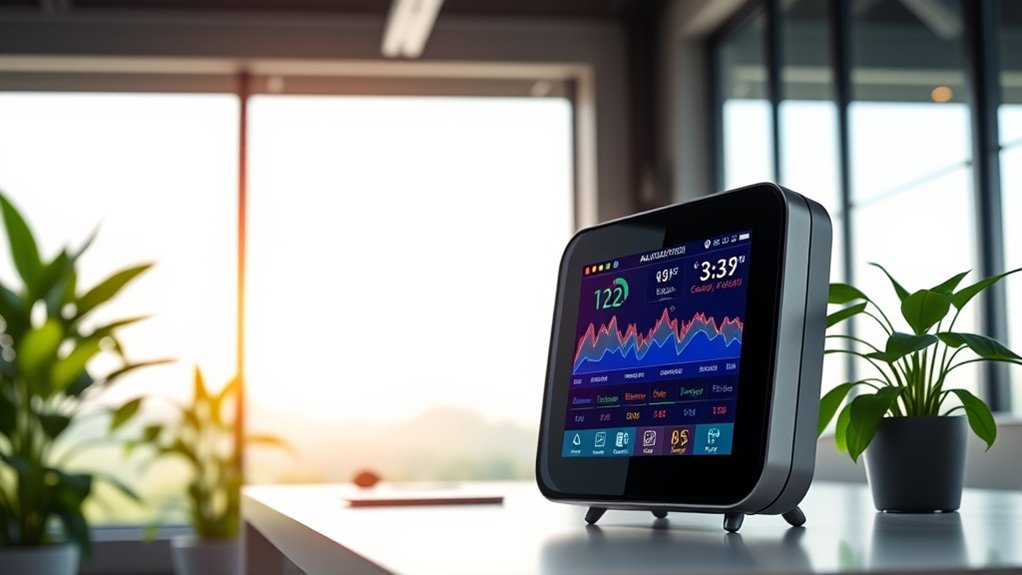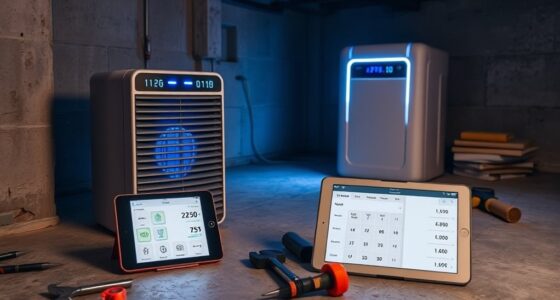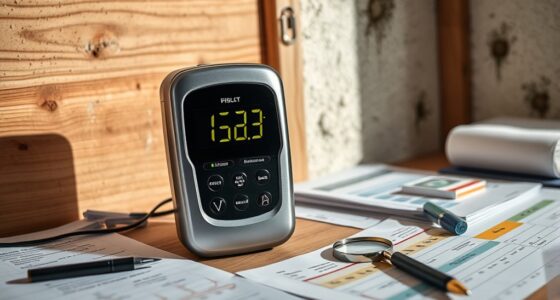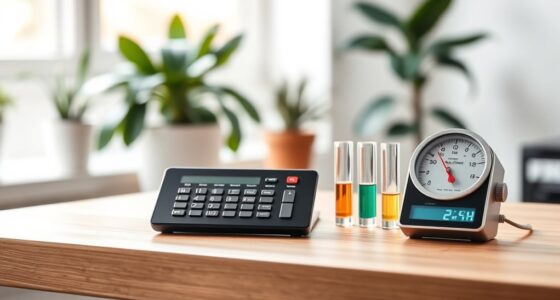To rate your indoor environment, use an air quality score calculator that assesses pollutant levels, ventilation, and sources of contamination. These tools analyze data from your indoor space to give a clear score, helping you understand how safe and healthy your air is. Regularly monitoring your indoor air quality allows you to identify problems and take targeted actions. Keep exploring further to discover more ways to improve your indoor environment and protect your health.
Key Takeaways
- An air quality score calculator assesses indoor pollutant levels, ventilation, and sources to provide a safety rating.
- It simplifies complex air quality data into an easy-to-understand score for quick evaluation.
- Regular use helps identify when indoor air quality declines and intervention is needed.
- The calculator guides improvements by highlighting specific pollution sources and risks.
- Monitoring scores supports maintaining a healthier indoor environment and reducing health hazards.

Ever wondered how clean the air around you truly is? Many of us go about our daily routines without considering the quality of the air we breathe indoors. Yet, indoor air quality can profoundly impact your health, comfort, and overall well-being. Using an air quality score calculator can help you evaluate your indoor environment’s healthiness by providing a clear picture of air pollution levels and indoor air hazards. These tools analyze various factors, including pollutant concentrations, ventilation efficiency, and sources of indoor contaminants, giving you a tangible score that reflects your indoor air’s safety. With this information, you can make informed decisions to improve your living space and reduce health risks associated with poor air quality.
Understanding air pollution levels inside your home or office is vital because indoor air can often be more polluted than outdoor air. Common indoor air hazards include volatile organic compounds (VOCs) emitted by cleaning products, paints, and furnishings, as well as particulate matter from cooking, smoking, or even dust accumulation. Mold and mildew growth, often caused by excess moisture, can also contribute to hazardous indoor air conditions. These hazards may not always be visible, but they can cause a range of health issues, from allergies and respiratory problems to more severe conditions like asthma or even cardiovascular diseases over time. An air quality score calculator takes these risks into account, offering a snapshot of your indoor environment’s safety level.
Indoor air can be more polluted than outdoor air, posing health risks from VOCs, dust, mold, and other hazards.
By regularly checking your indoor air quality score, you gain insight into how well your space is ventilated and how effectively you’re managing indoor air hazards. For example, if your score indicates high pollution levels, you might need to improve ventilation, use air purifiers, or switch to less toxic household products. The calculator can also help you identify specific sources of indoor pollutants, empowering you to take targeted actions. Monitoring your indoor air quality isn’t just about comfort; it’s about safeguarding your health and that of your loved ones. Poor air quality can often go unnoticed, but with a simple score, you get a clear metric that highlights when intervention is needed.
Additionally, understanding the types of air purifiers and their respective filtration methods can significantly enhance your efforts to improve indoor air quality. Ultimately, an air quality score calculator provides a practical, accessible way to understand and manage indoor air hazards. It transforms complex data into actionable insights, making it easier for you to create a healthier environment. Whether you’re concerned about allergies, asthma, or simply want to breathe cleaner air, regularly evaluating your indoor air pollution levels can make a profound difference. Take control of your indoor environment today and breathe easier knowing you’re paying attention to the air quality that surrounds you every day.
Frequently Asked Questions
Can the Calculator Detect Specific Indoor Pollutants?
The calculator can’t directly detect specific indoor pollutants like VOC levels or mold. Instead, it assesses your environment based on factors like air quality, humidity, and other indicators that suggest pollutant presence. If you suspect high VOC levels or mold, it’s best to use specialized testing kits or consult an indoor air quality professional. This way, you get accurate detection and effective solutions for maintaining a healthier indoor space.
How Often Should I Check My Indoor Air Quality?
Think of your indoor air as a delicate garden needing regular tending. You should check your indoor air quality at least once a month to make certain it meets air quality standards and stays free from indoor pollution. If you notice odors, increased dust, or symptoms like allergies, check more frequently. Regular monitoring helps prevent harmful buildup and keeps your environment safe and healthy.
Does the Calculator Account for Humidity Levels?
Yes, the calculator considers humidity impact when evaluating your indoor air quality. Proper moisture control is essential because high humidity can lead to mold growth and poor air quality, while low humidity can cause dryness and discomfort. By factoring in humidity levels, the calculator provides a more accurate score, helping you identify areas needing moisture control to improve overall indoor environment health.
Is the Tool Suitable for Commercial or Industrial Spaces?
You’ll love how this tool transforms your commercial or industrial spaces into air quality superheroes, catching every tiny pollutant like a magnet. It’s perfectly suited for large-scale environments, from bustling factories to sleek office buildings. With its advanced sensors and real-time data, you can confidently monitor and improve air quality, ensuring your space remains safe and healthy for everyone. It’s the ultimate defender in maintaining ideal indoor environments!
Can It Recommend Specific Air Purification Devices?
Yes, the tool can recommend specific air purifiers based on your indoor environment’s air quality data. It assesses device suitability by considering factors like room size, pollutant levels, and airflow. This helps you choose the best air purifier recommendations tailored to your space, ensuring ideal air quality. By analyzing your environment, it guides you toward effective solutions that improve air cleanliness and your overall indoor health.
Conclusion
Now that you’ve got the tools to rate your indoor air, you’re well-equipped to breathe easier—no need to summon a wizard from the days of yore. Regularly check your air quality score and take steps to improve it, just like a savvy modern alchemist. Remember, your environment influences your health more than you might realize. So, embrace this knowledge, stay vigilant, and turn your humble abode into a castle of clean, fresh air.









